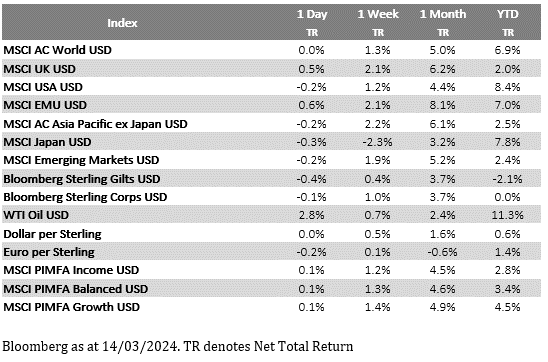Please see below, an update from Evelyn partners detailing the March inflation figures and Monetary Policy Committee meeting outcome. Received today – 21/03/2024
What happened?
The Bank of England (BoE) held the base rate at 5.25% at their meeting today. This was consistent with market expectations and marks the fifth consecutive meeting where rates have been held at this level.
There was, however, a notable shift in the committee votes, with nobody voting to increase interest rates. Eight members voted to hold the base rate at 5.25%, with Jonathan Haskel and Catherine Mann dropping their votes for higher interest rates, while Swati Dhingra continued to vote for a 25 basis point cut.
This follows February’s CPI print (released Wednesday), which came in slightly softer than expected at 3.4% year-on-year (vs consensus of 3.5%). Core CPI, which better reflects domestic price pressures, was reported at 4.5% year-on-year (vs consensus of 4.6%).
What does it mean?
As anticipated, the BoE held the base interest rate at 5.25%. But today’s change in votes signals that we are getting closer to interest rate cuts. Haskel and Mann, longstanding hawks, dropped their votes for higher rates, making this the first meeting since September 2021 with no votes for higher rates.
Moreover, the softer than expected February inflation print should give the monetary policy committee (MPC) more confidence that inflation is on the right track. CPI rose by 3.4% in the 12 months to February 2024, down from 4.0% in January. The largest downward contributions to the CPI annual rate came from food, and restaurants and cafes, while the largest upward contributions came from housing and household services, and motor fuels. Although the services component of CPI remains elevated at 6.1% year-on-year, and the MPC will want to see more progress on this measure before they commit to a rate cutting cycle.
On the growth side, the data is showing tentative signs that UK economic growth might be turning the corner. The UK composite PMI reading for March was 52.9, marking the third month in a row above 50 (50 signals expansion vs the previous month). This implies that the technical recession experienced in the second half of 2023 is now over.
Today’s meeting doesn’t seem to have materially changed the calculus for money market traders, although the probability of a June rate cut has increased to 70% from 50% at the start of this week. The market took the decision and communications as dovish, with sterling weaker against the US dollar and gilt yields falling across the curve.
Bottom Line
The BoE held interest rates at 5.25%, although today’s change in voting patterns signals that we are getting closer to a first interest rate cut. We continue to expect this will materialise around the middle of the year as inflation decelerates to the 2% mark.
Please continue to check our blog content for advice, planning issues and the latest investment, market and economic updates from leading investment houses.
Alex Kitteringham
21st March 2024









